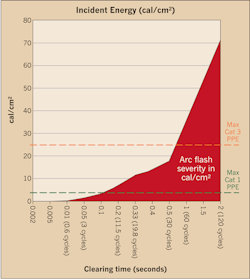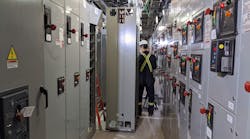More and more companies today are taking the smart step toward performing an arc flash analysis on their electrical distribution system to determine arc flash hazard levels and accurately post the hazard level on associated equipment. However, once the study is completed, most firms never give it another thought — assuming the arc flash calculations will always accurately reflect the hazard in the field.
After the analysis is complete, there is no reason to second-guess the engineer who performed the calculations. But the reality is, over time, the calculated arc flash hazard values are in jeopardy of becoming erroneous if the equipment is not part of an effective electrical equipment maintenance program (E3MP).
Arc flash severity variables
Three primary variables are required for the calculations associated with an arc flash analysis: available fault current, distance from the fault, and duration of the fault. Distance from the fault is determined by IEEE Standard 1584, “Guide for Performing Arc Flash Hazard Calculations,” and the fault current is a property of the electrical distribution system being evaluated. Fault duration is the variable that can be inadvertently impacted by a company’s electrical maintenance strategy. Fault duration is the characteristic of the arc flash event, which is determined by the upstream overcurrent protective device’s (OCPD’s) ability to interrupt the fault. For the purpose of an analysis, the engineer assumes the OCPD will interrupt the fault in the manner and speed at which it was designed.
Circuit breakers are one of the most common OCPDs and are considered as time-limiting equipment in the arc flash analysis. However, the time required for a circuit breaker to interrupt a fault can be dramatically impacted by the lack of proper maintenance. In order to better understand the relationship between circuit breaker maintenance and arc flash severity, you must first understand some basics related to circuit breaker design and operation.
What is a circuit breaker?
A circuit breaker is a switching device that can be operated manually or automatically for control and protection of an electrical power system. From a protection standpoint, circuit breakers are devices that automatically stop current from flowing if a certain abnormality in the system is detected — in simple terms, it interrupts the flow of current in the circuit.
There are two main types of circuit breakers: magnetic and thermal. Magnetic circuit breakers respond quickly to short-duration large overcurrent faults, while thermal circuit breakers respond best to long-duration small overcurrent faults. In addition, a thermal-magnetic circuit breaker combines the advantages of both types, breaking circuits in response to both large overcurrent and prolonged small overcurrent conditions. Magnetic circuit breakers are more relative to the arc flash discussion in that they are typically the breakers responsible for clearing short-duration large overcurrent faults that involve arc flash events.
Magnetic circuit breakers rely on induction through a coil of wire called a solenoid. When current flows through the solenoid, a magnetic field is created. This field exerts a force on a nearby magnet; the larger the current, the stronger the force. If the current is strong enough, the magnet is pushed out of the solenoid with enough force to trip the mechanism that breaks the circuit. This is useful if there is a sudden surge in current, because the force created by the solenoid increases proportionally with the amount of current, allowing a rapid response for fault interruption.
Why circuit breaker maintenance is crucial
A circuit breaker is a mechanical device, so inherently it has components that are required to move in order for a successful operation. When calculating incident energy levels, the engineer would use information from the manufacturer with regard to how quickly those mechanisms work together to complete the operation and interrupt the circuit. Each breaker is designed to interrupt fault current based on its time-current characteristics curve. These design characteristics are used in the arc flash analysis calculations to determine the fault clearing time.
If an E3MP is not utilized on a breaker, then the operating times provided by the manufacturer become irrelevant. Circuit breaker mechanisms will start to malfunction (contacts can start to stick and grease can begin to “gum up”). Even worse, the breaker might not work at all. A delay in response time might not seem like much, but it only takes milliseconds for the incident energy on a typical 480V motor starter to go from negligible to deadly.
Impact of increased fault clearing time
The Figure shows arc flash values for a typical 480V motor starter breaker in a system with 3kA of available fault current. The y-axis is the arc flash energy level in cal/cm2. Time is shown along the x-axis starting at 2 msec up to a maximum of 2 sec. Notice how quickly the incident energy level rises.
Let’s assume the breaker is designed to clear the fault in three cycles. The calculation for this example results in an incident energy level of 2.2 cal/cm2, which would require a minimum of Category 1 personal protective equipment (PPE). If the lack of proper maintenance causes the breaker to not clear the fault until 30 cycles (0.5 sec), the incident energy level reaches 22.2 cal/cm2. This would require a minimum of Category 3 PPE. The significance of this time delay is that the electrician wearing typical Category 2 “daily wear” PPE would be insufficiently protected from the arc flash energy levels produced during the fault, regardless of what the warning sticker on the equipment states as the required PPE.
Conclusion
Even if a company has the most accurate and detailed arc flash analysis performed on its system and provides employees with top-of-the-line PPE, there is still a safety-related responsibility for the establishment of an E3MP. If the company does not incorporate an E3MP on all OCPDs, then employees remain at risk of being injured due to the probability of arc flash events that exceed calculated values. Without an E3MP, the probability is higher that the operating speeds of the mechanical parts in your breakers are significantly slower than designed, and, as demonstrated in the example above, it takes only fractions of a second to defeat all of the efforts associated with an effective arc flash mitigation program.
Northcott, a professional engineer licensed in the state of Tennessee and a certified maintenance and reliability professional, is a senior power engineer with Jacobs Technology, Inc., in Tullahoma, Tenn. He can be reached at [email protected].






